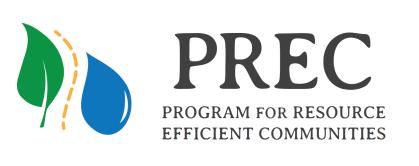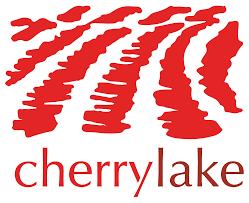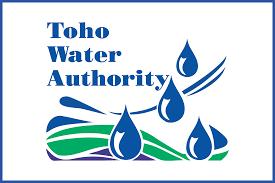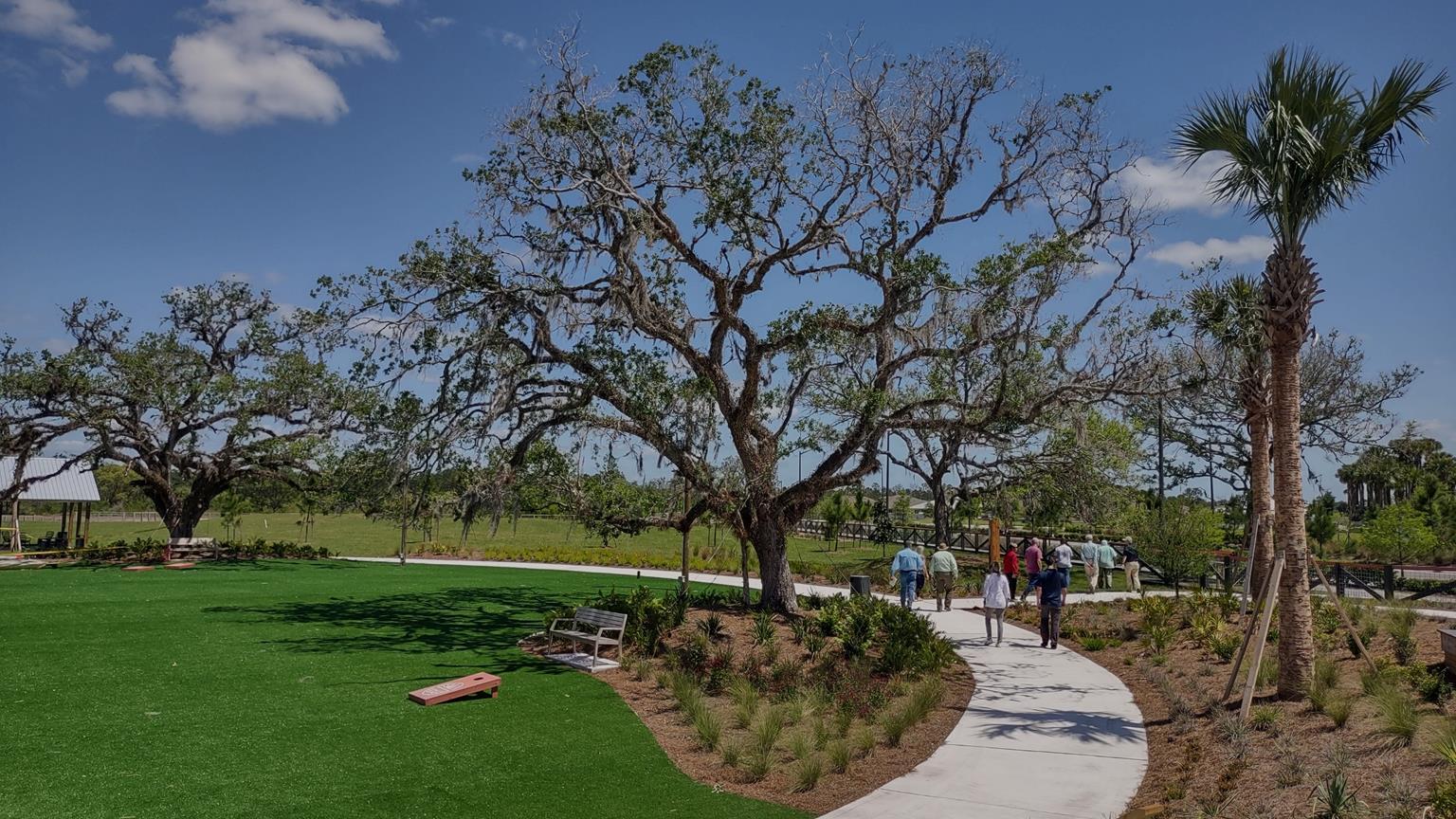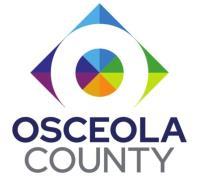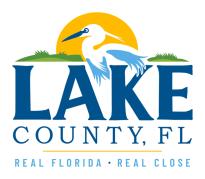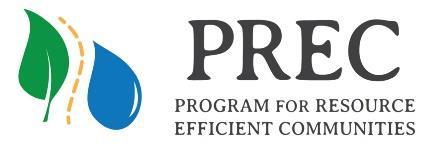2024 Florida Planning Conference



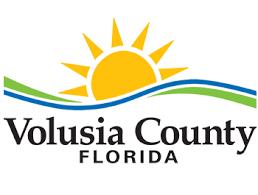





Michelle “Mo” Morrison
Planner
East Central Florida Regional Planning Council
LID+GSI Code Audit Spreadsheet Tool (CAST)
Eban Bean, Ph.D., P.E.
Associate Professor & Extension Specialist
UF/IFAS Extension Program for Resource Efficient Communities

LID+GSI Ordinance Recommendations
Jerry Murphy, JD, AICP, CFM
Faculty Consultant
UF/IFAS Extension Program for Resource Efficient Communities
State Specialized Program Agent (SSPA) – Flood Resilient Communities



LID+GSI Ordinance Implementation: Are we there yet?
Ginger Adair
Environmental Management Director
Volusia County
M. Jennison Kipp
Resource Economist
UF/IFAS Extension Program for Resource Efficient Communities




▪ Community Planning Technical Assistance Grant, Ch 163.3168, F.S.
Help communities find creative solutions to foster vibrant, healthy communities, while protecting the functions of important state resources and facilities
▪ Advance resilient, nature-based stormwater strategies
▪ Consider mechanisms, incentives, and processes to incorporate LID in Volusia County site planning and stormwater management
▪ Share outcomes throughout East Central Florida region and beyond



Intro to LID+GSI Community Scoping and Code Audit Tool, MRC LID Conference (Oct. 2022), Eban Bean
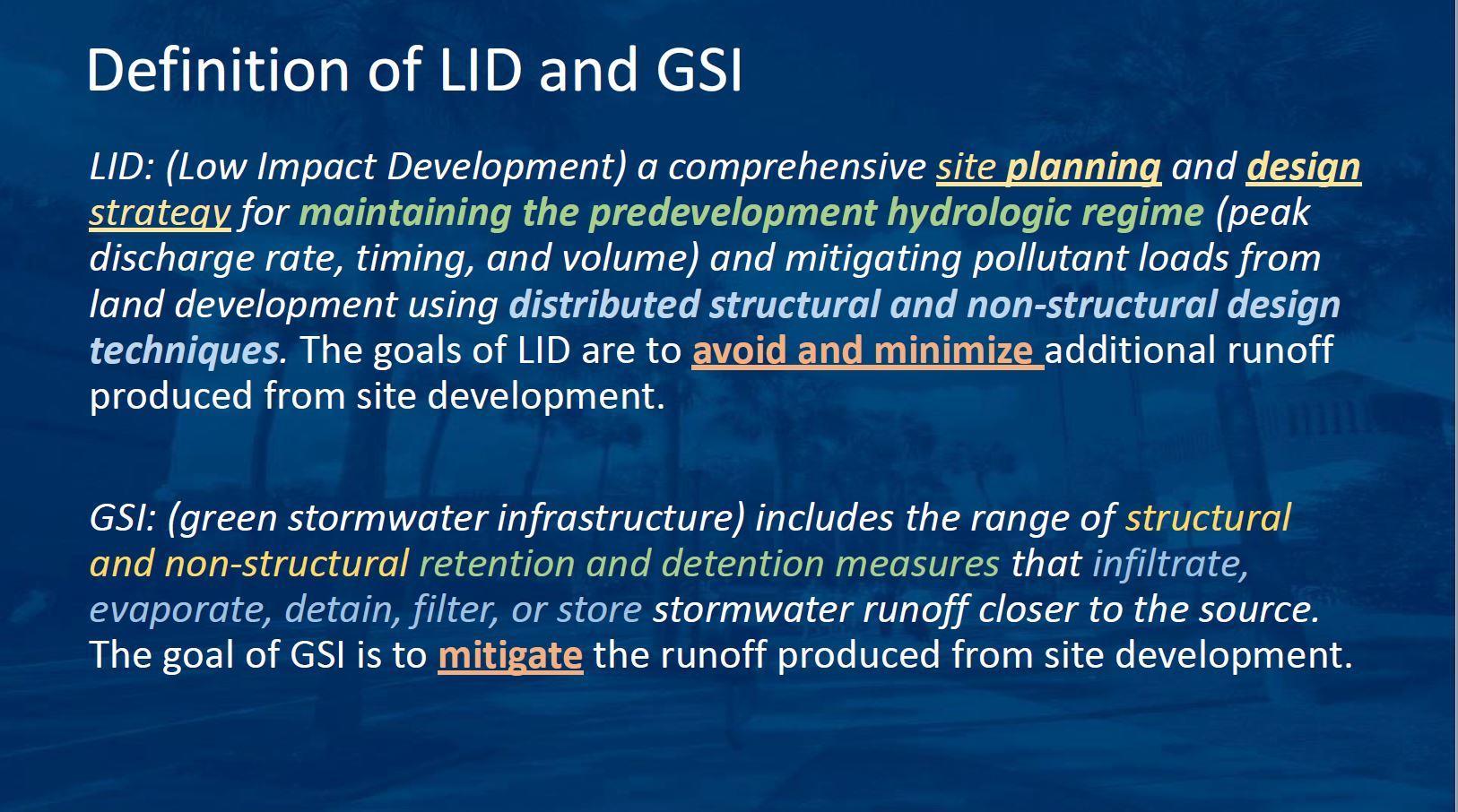

Intro to LID+GSI Community Scoping and Code Audit Tool, MRC LID Conference (Oct. 2022), Eban Bean
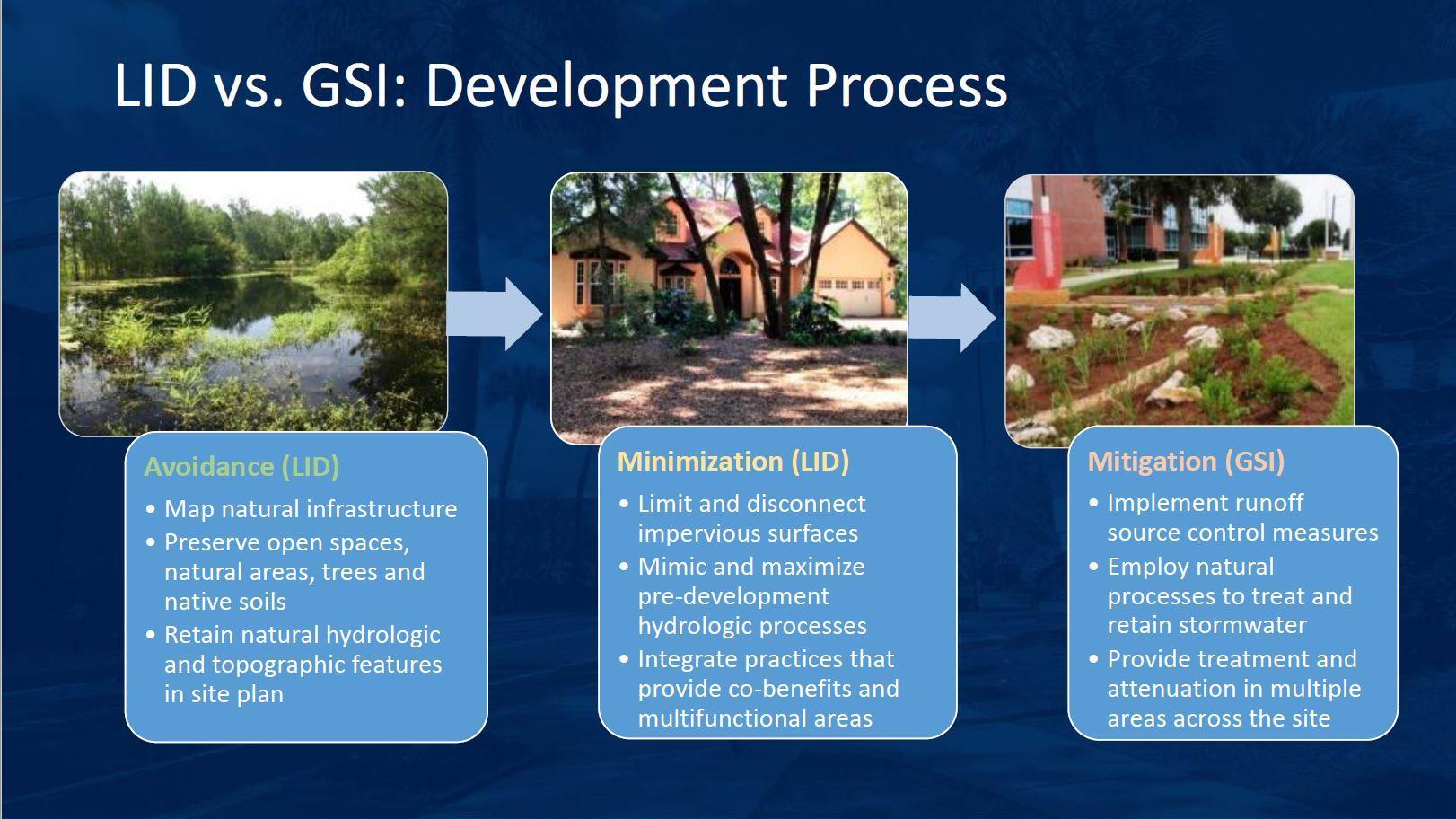



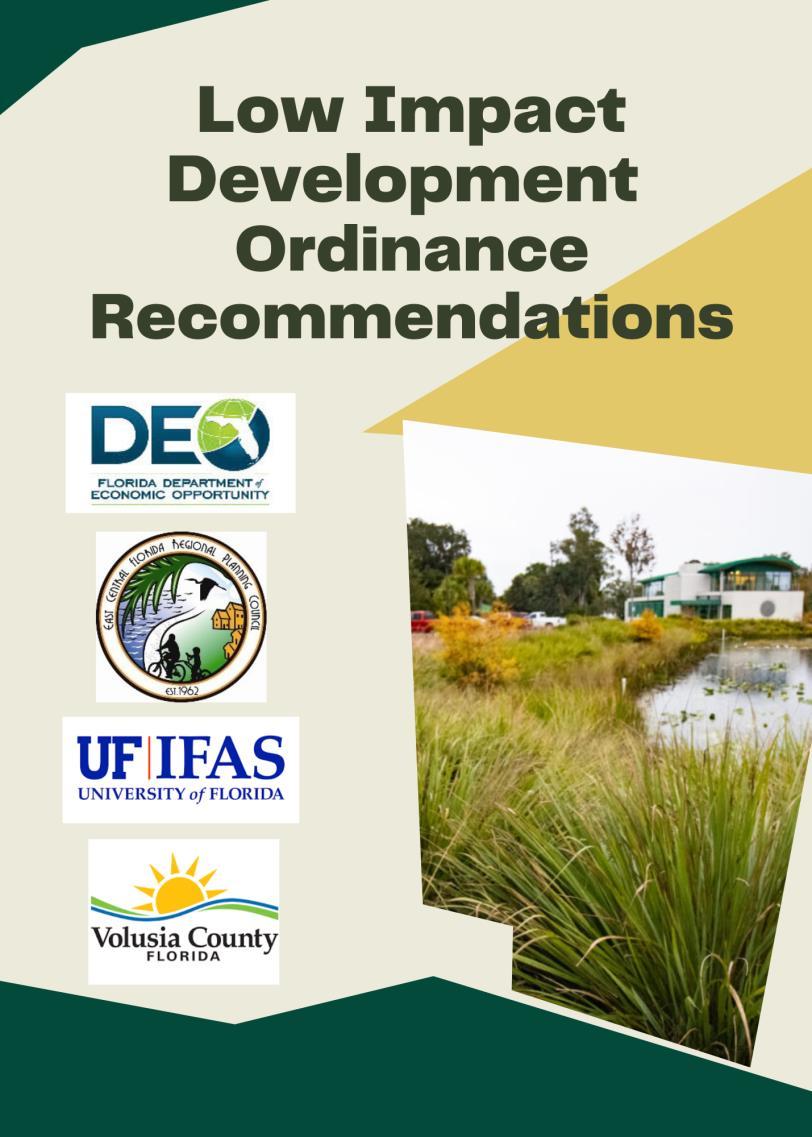

▪ Infill, redevelopment
▪ Reduced and disconnected a previously 100% impervious area from the City’s piped stormwater conveyance system
▪ Infiltrates ~100% stormwater on site
▪ Integrated system of roof gutters/downspouts, infiltration basins, parking areas graded to flow into grassed swales, open areas, and trees
▪ Parking lot bioswales
▪ Mechanical reworking of compacted soil




Photo Source: Sarasota County Government (https://www.sarasota.wateratlas.usf.edu/lid/#rain-gardens
(Sarasota, FL) ▪ Rain gardens capture roof runoff ▪ Pervious pavers in driveway and parking lot
▪ More of site for restaurant & parking, avoided need for retention pond

▪ 5-story apartment complex
▪ Infill, redevelopment
▪ Infiltrate ~100% stormwater on site
▪ Integrated system of roof gutters/downspouts, infiltration basins/ponds, grassed bioswales and open areas, and trees
▪ Drainage and biological capacity of soils restored through mechanical reworking of soils and soil amendments using native topsoil
▪ Redevelopment included removal of all existing impervious areas (structures and pavement)
▪ Under-building parking reduced impervious area by 50%
▪ LID practices located within routinely maintained landscaped areas


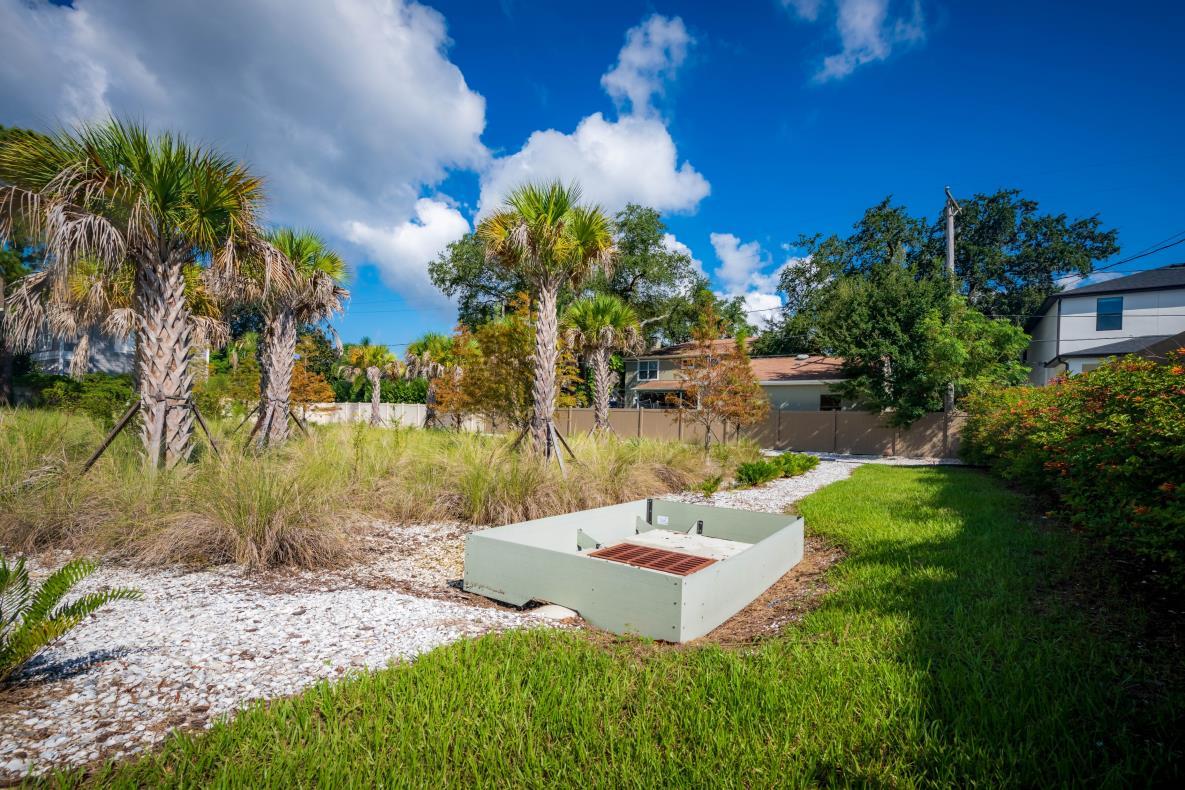
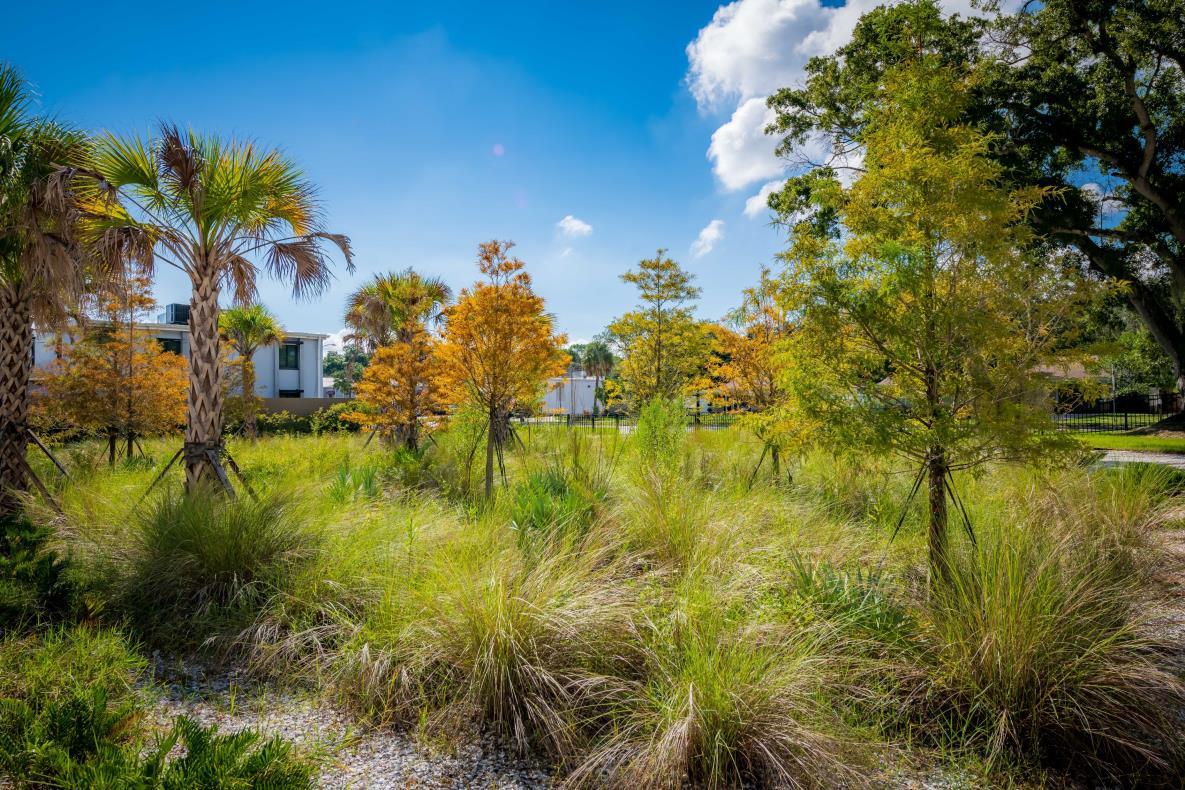
Source: https://gsiphotosflorida.org/photo/stormwater-drainage-at-el-prado-stormwater-garden/ The Nature Conservancy All Rights Photo credit: Roberto Gonzalez
El Prado Stormwater Garden (Tampa, FL)
▪ SWFWMD Cost-Share Funding Project
▪ Created to address stormwater flooding in residential areas
▪ Amended soils, bioretention, gravel pathway & storage areas, native vegetation



Beach Park Restroom
Source: Sarasota County Government
Sarasota County: Municipal & Commercial


▪ Restroom – reduce runoff, cooling for restroom with no AC, wildlife habitat, native landscaping
▪ Bar & Grill – funded through Sarasota Bay Estuary Program grant, FFL, cisterns capture excess rainwater used for irrigation and pressure washing building
Reducing Landscaping Impacts
The Villages (Sumter County) Source: UF/IFAS
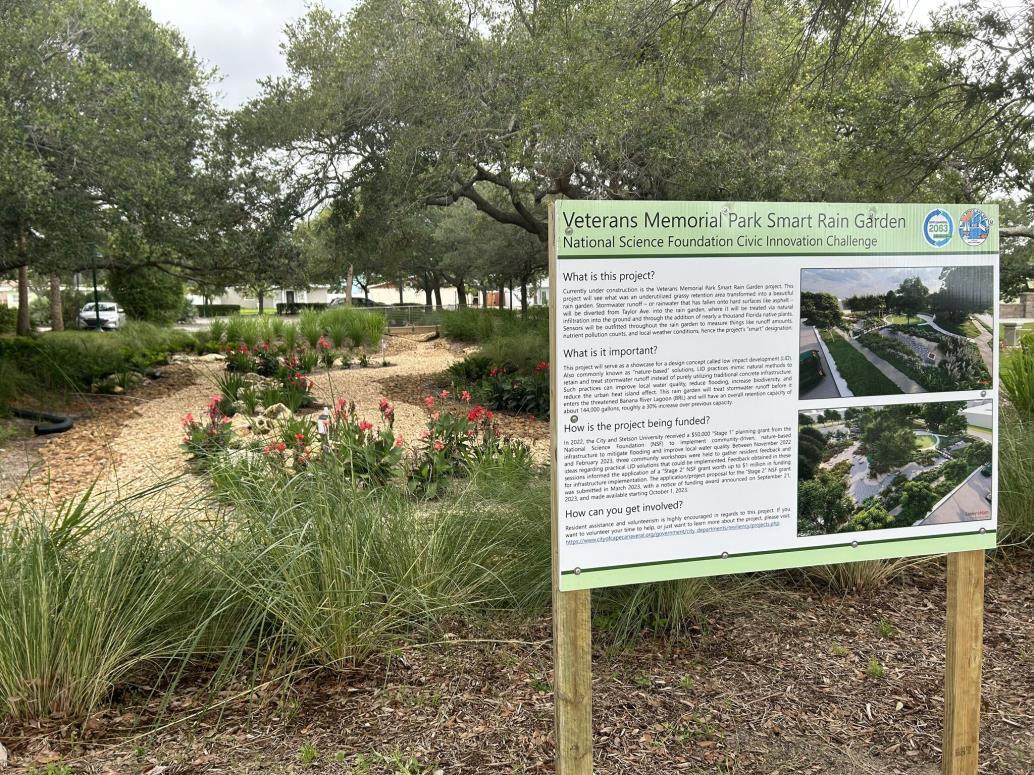
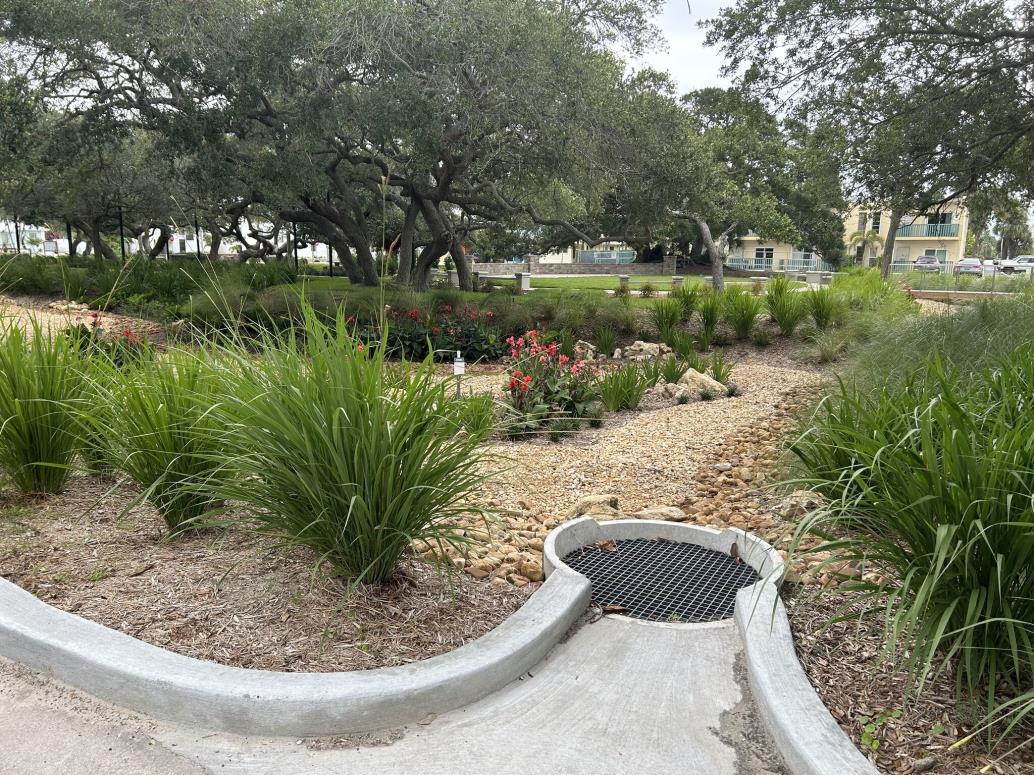
▪ NSF CIVIC Innovation Challenge Grant ($1M)

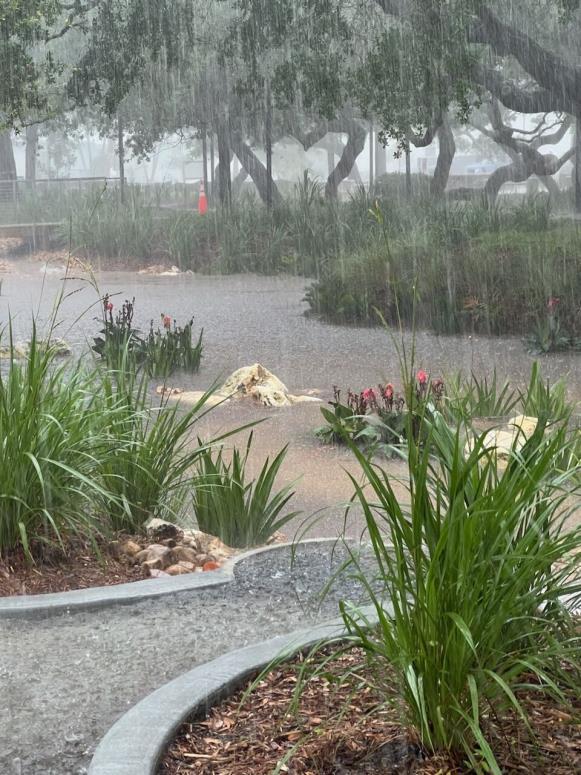
▪ Partners: City of Cape Canaveral, Stetson University, MRC, SJRWMD, ECFRPC, Riverside Conservancy, Kimley-Horn, Ferguson, Florida
SeaGrant, IRL NEP, Embry-Riddle, City of Cocoa Beach, Brevard Zoo
▪ Sensors measure runoff volume, nutrient pollution counts, local weather
▪ Retrofit: increase retention capacity 30% to 144K gal
▪ Showcase LID benefits: improve water quality, protect Banana River Lagoon, reduce flooding, increase biodiversity, reduce heat island effect


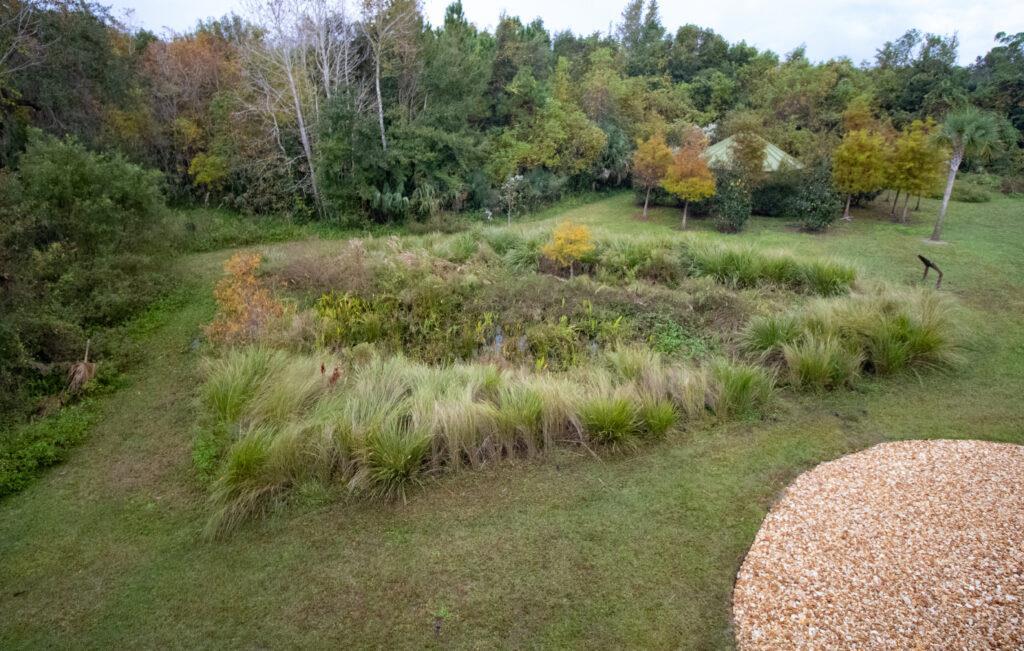
Source: https://gsiphotosflorida.org/project/stetson-aquatic-center/ The Nature Conservancy All Rights Photo credit: Tyler Jones
▪ Stetson Institute for Water & Environmental Resilience
▪ GSI Demonstration project
▪ Biofiltration, rain garden, floating wetland system/beemat, native vegetation
New buildings and redevelopment sites shall incorporate the following low impact development (LID) practices into project design, site and building plans…
Developers shall implement the following non-structural LID practices to the maximum extent practical
Developers shall implement a minimum of two structural LID practices from the following list, where one meets the water quantity requirement and the other meets the water quality requirement, per Section 11.0 of the 2021 LID Master Plan Update and the SFWMD ERP Applicant's Handbook Volume II.
Maintenance is required to preserve the efficacy of the implemented LID practice(s).
To encourage developers to design site plans using more than the minimum required LID practices, the City may offer the following incentives: Expedited review of permits, Implementation of open space credit, Reduced application fee, Award recognition program
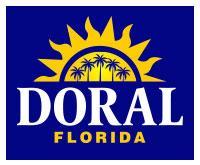


Reducing Landscaping Impacts
The Villages (Sumter County) Source: UF/IFAS

Incentives include:
▪ Technical assistance for LID practices
▪ Plan review fees waived
▪ Permitting/site development credits
▪ Process expedited
▪ Additional density (height, lot coverage)
▪ Setback reduction
▪ Parking reduction

▪ Stormwater fee credit (up to 52%) to non-SFH property owners to operate and maintain onsite detention or retention stormwater management systems
▪ Stormwater fee credit (up to 50%) to non-residential property owners who reduce water pollution by implementing LID and GSI practices
▪ Rebates for Florida-Friendly landscaping, irrigation, rain gardens, and rain barrels
▪ Stormwater on-site mitigation loan program to prevent or reduce future interior flooding for residents
Reducing Landscaping Impacts
The Villages (Sumter County) Source: UF/IFAS









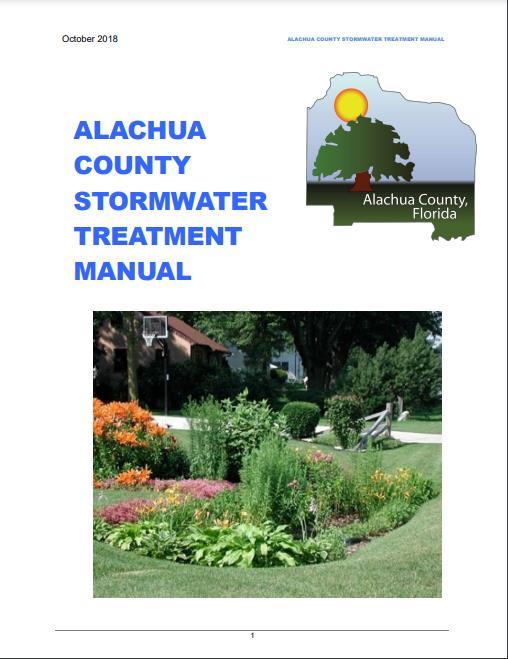






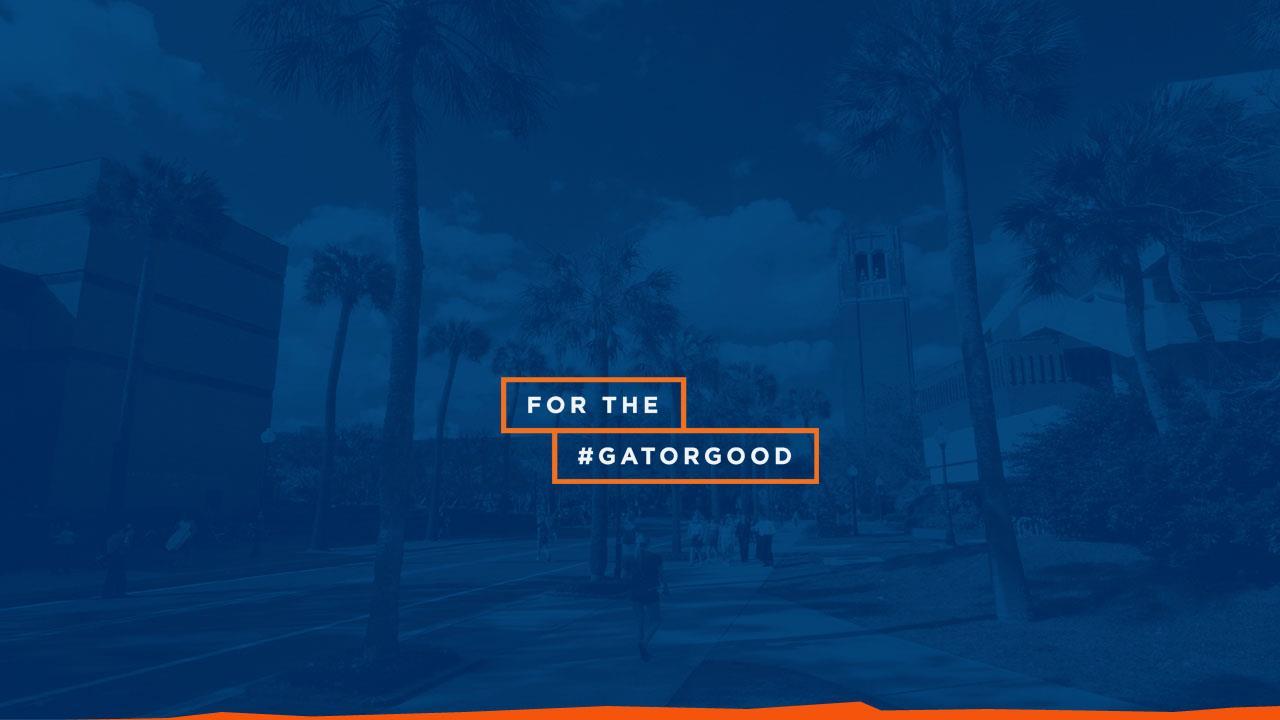
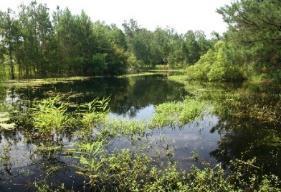
City or County Level:
Codes & Ordinances, Comprehensive Plans, & Zoning

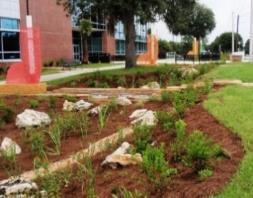
FDEP & WMDs:
TMDL/BMAP, MS4, ERP Programs
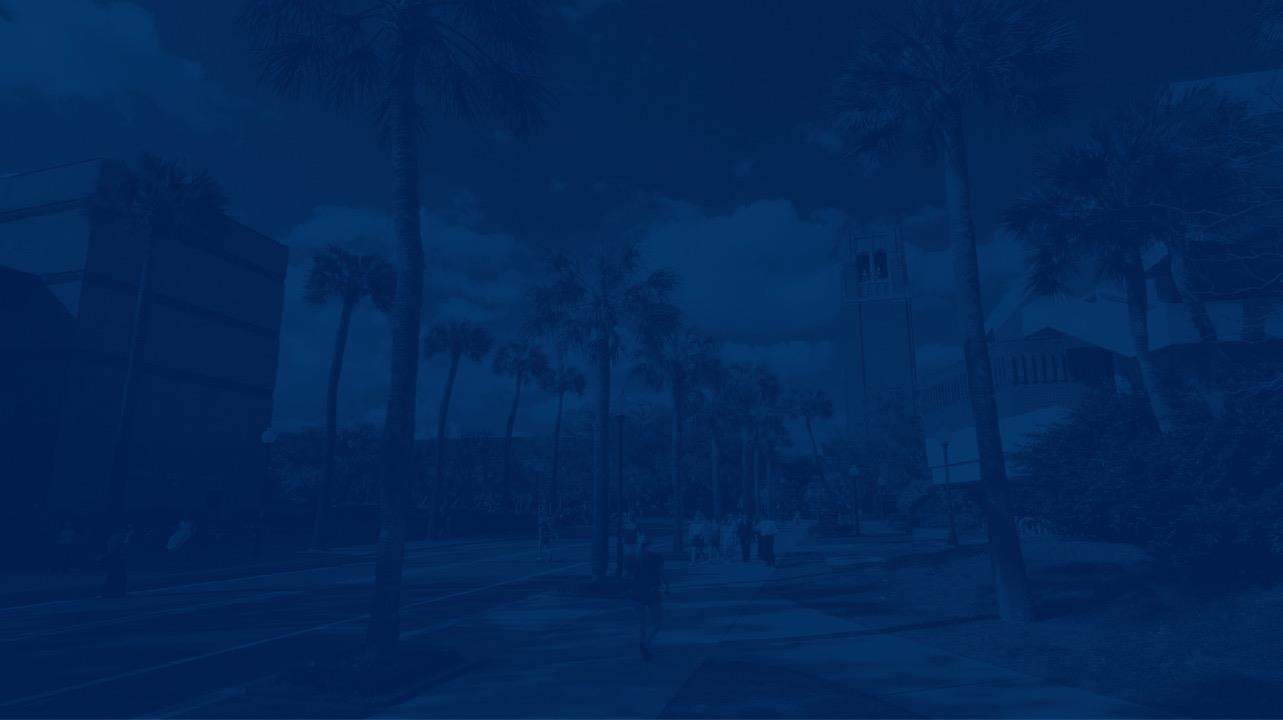
Avoidance (LID)
• Map natural infrastructure
• Preserve open spaces, natural areas, trees and native soils
• Retain natural hydrologic and topographic features in site plan
Minimization (LID)
• Limit and disconnect impervious surfaces
• Mimic and maximize predevelopment hydrologic processes
• Integrate practices that provide co-benefits and multifunctional areas
Mitigation (GSI)
• Implement runoff source control measures
• Employ natural processes to treat and retain stormwater
• Provide treatment and attenuation in multiple areas across the site
Provide minimum stormwater treatment “performance” criteria – no longer “technology based” or “presumptive”.

Increase overall treatment and removal of nutrients (TP and TN)
Ensures consistent application of net improvement performance standards.
Establish updated stormwater best management practices that more accurately reflect latest scientific information on their performance.
Strengthens requirements for operation and maintenance of stormwater systems.
• Commercial and residential codes
• Directly/indirectly increases impervious parking areas
• Seldomly used spaces
• Pervious parking

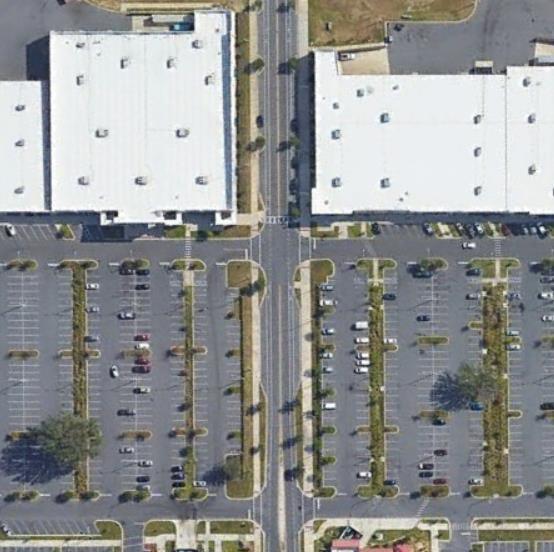



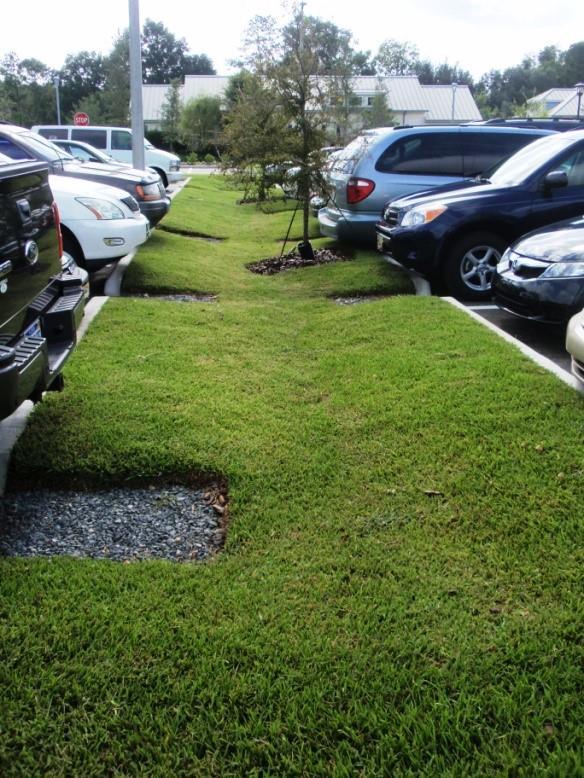
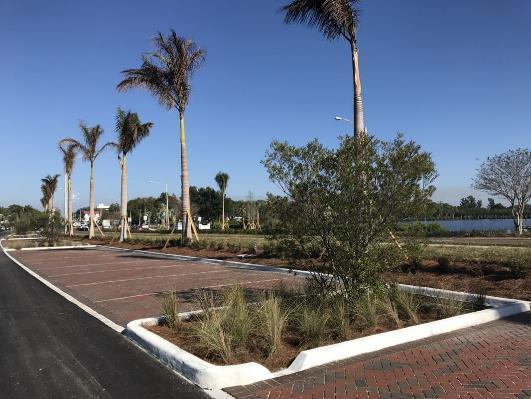
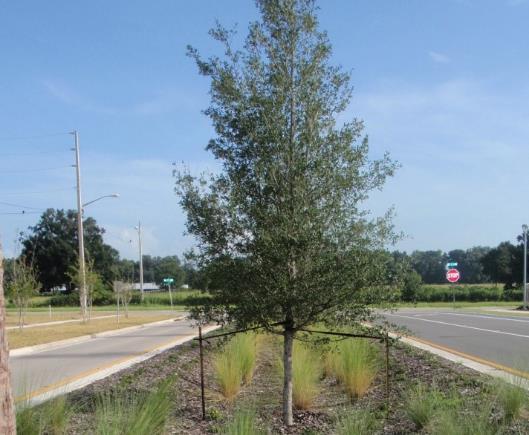
Curb and gutter requirements indirectly prohibit swales.
• Based on:
• WI Sea Grant Tool
• Center for Watershed Protection Tool
• Adapted to Florida’s Karst and Coastal Areas
• Partnership between UF IFAS. TNC Florida, and Eric Livingston
• Identify explicit & implicit restrictions or barriers to LID+GSI
• Coordinated & objective review of codes
• Identify weak areas of code that can be addressed currently or when opportunity arises


• Code Audit Spreadsheet Tool (CAST)
• Overall sections:
Comprehensive Plan
Protecting Nature
Stormwater and Water Quality
The Built Environment
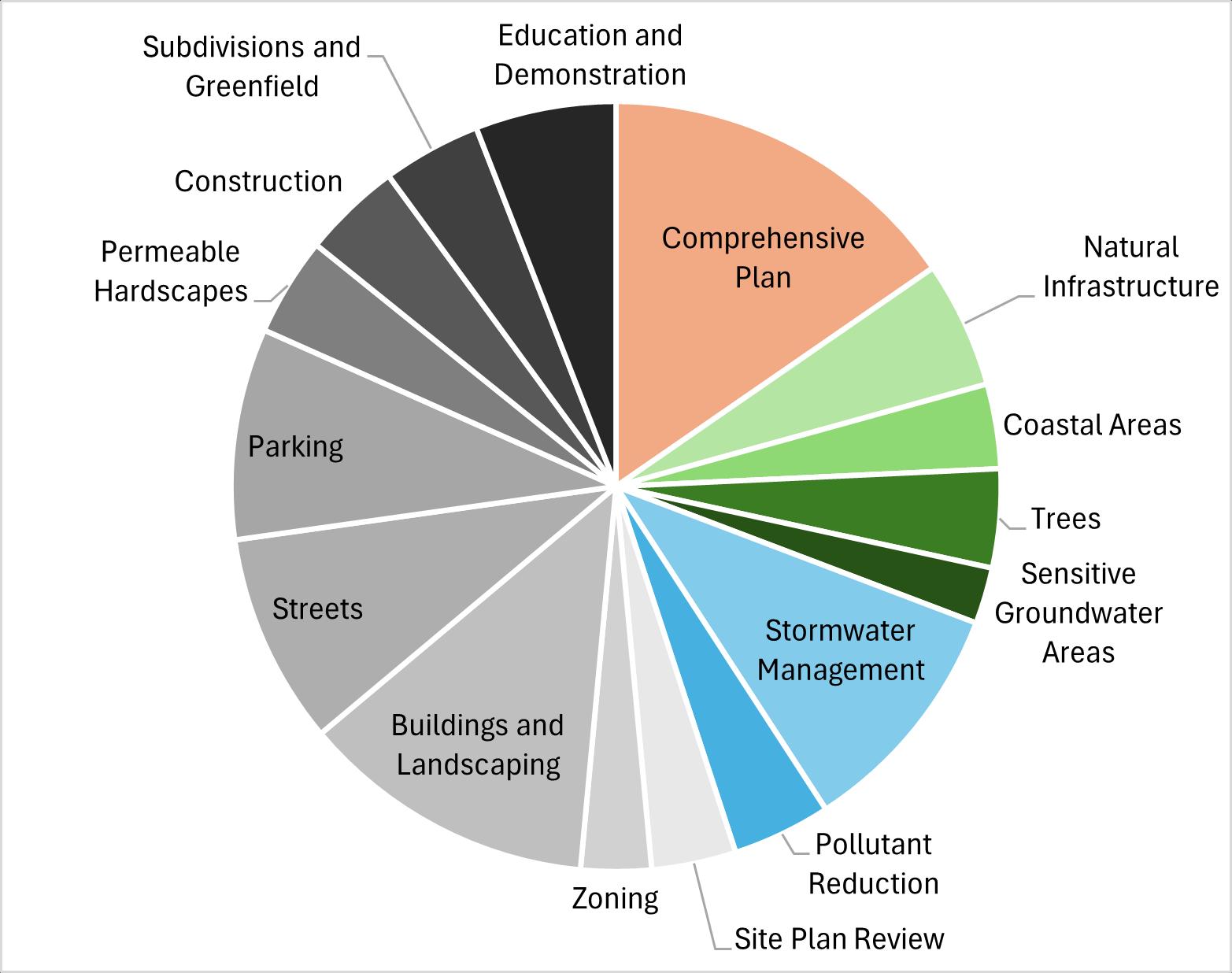

4 Practice is clearly described and approved or is allowed with design approval.
3 Practice is encouraged, but some ambiguity or potential conflict exists.
2 Practice is mentioned, but without standards or guidance for use.
1 Code is silent or significant limits exist, but practice could possibly be used.
0 Practice is prohibited or very unlikely to be approved.

Where feasible, parking lot islands and perimeter landscaped areas shall be designed and installed to function as stormwater management areas, following design standards for bioretention found in the Stormwater Design Manual. If not feasible, native plants, suitable for the site shall be used.
Parking lot islands and perimeter landscaped areas are encouraged to be designed as part of the site’s stormwater management system, based on bioretention standards in the Stormwater Design Manual. Trees must be planted at a maximum interval of 20 feet.
Landscaped areas in parking lot perimeters and islands may be designed and used as stormwater bioretention areas.
Landscaping in parking lot islands and perimeters must achieve a minimum of 75% cover within two years of planting.
Parking lot perimeters shall be graded into a berm with a minimum slope of 2:1, covered with landscaping that will form a dense evergreen screen within tow years of planting.
Administrative
• About
• Definitions
• Codes Review Log
• Contact Information
• Scoring Instructions
• Score Summary
Local Government Planning and Policy
• Comprehensive Plan
• Zoning
Protecting Nature
• Natural Resources Protection and Management
• Coastal Areas
• Trees
• Sensitive Groundwater Areas
Stormwater and Water Quality
• Stormwater Management
• Pollutant Reduction
The Built Environment
• Site Plan Review
• Buildings & Landscape
• Streets
• Parking
• Permeable
• Construction
• Subdivisions & Greenfield
• Education and Demonstration

M7. Is shared parking allowed for multiple businesses or sites with different peak usage times?
Tips
Purpose: Reduce number of onsite parking spaces
Facilities in close proximity to each other with different peak usage times, e.g., stores, restaurants, churches, and recreation areas, are good candidates to share parking. Physical access may be needed at multiple locations, and a legal agreement is necessary. Maintenance responsibilities must be addressed.
Code References
Sec. 407.18. - Parking reductions or increases.
Article 40 chapter 407 Sec. 407.68.Transit supportive area design standards. (2)Parking spaces may be pooled and utilized anywhere within the development.
Notes, Ideas and Strategies Score
Code does not specifically address "Peak usage times" but it does consider shared parking as a means of sufficient documentation for a decrease in off street parking spaces
Consider providing guidance for the documentation including this approach. 2

Community Scoping Exercise

• Assess GSI in the community and local acceptance of GSI, identify local natural resources, identify water quality and stormwater challenges and solutions
• ID specific code sections or topics for the audit

Code Audit Spreadsheet Tool
• Adapt CAST to full or partial audit
• Work through questions, finding & referencing code locations
• Record comments and score questions
• Identify weak areas of code

After the Audit
• Prioritize code amendments for local needs
• Draft suggested code revisions (Part 2 in development)
• Evaluate and address financial concerns
• Develop LID+GSI capacity (e.g., construction, inspection & preventative maintenance knowledge & procedures)





Does code require a conservation and restoration strategy that identifies and protects natural areas, prioritizing those providing stormwater management functions?
Gemini: 281 Words
Copilot: 265 Words
Claude: 175 Words
ChatGPT: 67 Words
Sec. 30-8.2. - General environmental performance standards.
Sec. 30-8.19. - Surface waters and wetlands review.
Sec. 30-8.20. - General requirements and procedures.
Sec. 30-8.21. - Avoiding loss or degradation of wetlands.
Sec. 30-8.2. - General environmental performance standards.
Sec. 30-8.13. - Regulation of natural and archaeological resources
Sec. 30-8.20. - General requirements and procedures.
Sec. 30-8.21. - Avoiding loss or degradation of wetlands.
Sec. 30-8.37. - Tanks.
(Incorrectly referenced, labeled “Natural areas protection strategy” in response)


UF/IFAS Program for Resource Efficient Communities
State Specialized Program Agent (SSPA) – Flood Resilient Communities
murphyge@ufl.edu

Intent and Purposes. Applicability.
Environmental Site Design (ESD).
Site Design Strategies.
Pollutant Removal.
Channel Protection Flow.
Conveyance Flow.
Flood Protection.
High Density Residential and Non-Residential Redevelopment Projects.
Land Uses with High Pollutant Loads.
Implementing and Integrating GSI + LID Strategies in Development.
Waiver of GSI + LID Requirements.



(a) Base Map. Qualified professionals identify, evaluate, and delineate natural resources on a boundary survey.
(b) Additional documentation. Soils; sub-watershed basin boundaries; generalized vegetative types; significant field-located trees that warrant protection from development; 20% slopes.
(c) Determination of Developable Area. (d) Preliminary Site Plans. (e) Reduce Impacts. (f) Manage Impacts.
Apply these strategies during the ESD process:

(a) Road Design; (b) Driveway Layouts; and (c) Lot Design.

(a) The Guidebook provides formulae to calculate pollutant loads.
(b) Procedure to calculate pollutant loads and the effectiveness of stormwater treatment systems—Pre-Development Conditions.
(c) Procedure to calculate pollutant loads and the effectiveness of stormwater treatment systems—Post-Development Conditions.
Channel Protection Flow
Conveyance Flow
Flood Protection

High Density Residential and Non-Residential Redevelopment
Projects
Land Uses with High Pollutant Loads
Implementing and Integrating GSI + LID Strategies in Development
Waiver of GSI + LID Requirements


1. Determine Objectives – Set goals and measures
Here we want to improve stormwater management and water quality through effective implementation of GSI + LID in new development and redevelopment projects; and wherever else possible
2. Analyze the Audience – Who can impact the objectives?
• Developers; Engineers; Home Builders; Property Owners; Public
• Regulators; Enforcers; Officials; Public
3. Fact Finding & Audience Involvement (ENRAC, etc.)

Here: What do we do to improve stormwater management and water quality through effective implementation of GSI + LID in new projects; and where ever else possible
Recommendation:
• Ordinance requirements for new development and redevelopment projects, e.g. residential subdivisions; large multi-family and nonresidential projects.
• Incentives for existing development.

4. Create Rules Structure and Develop Budget – rules of the program; fixed and variable costs
Here: Available resources to administer the program or need for additional resources; available processes to administer the program or need for new procedures; program management.
5. Select Awards – appeal; budget; match
What incentives will the Audience value? bonus density (caps), reduced dimensional regulations, fee waivers; property tax abatements, priority permit processing; compliance grants; etc.

6. Communicate the Program – Appropriate media to expand audience
Outreach to the public – possible parallel with the educational efforts we use to promote the local NFIP regulations to capture credits for the Community Rating System
7. Operations – Track results with regular progress updates
Again, a function of budget, capacity, and resources
8. Fulfill the Awards – more immediate = better!

9. Evaluate & Measure – Objective accomplished? Any outside factors?
This is the back end of steps 4 (Rules) and 7 (Tracking). Are we making progress toward our objective(s)?
10. Celebrate Success! – Reward achievers; communicate results; annual dinner; awards; public recognition.
This is probably the most public-facing aspect and provides additional incentives to participate whether through regulatory (LDRs) or voluntary compliance.
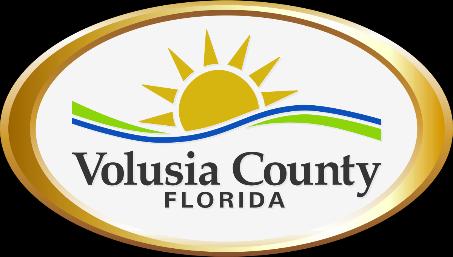
• Series of LID workshops 2021
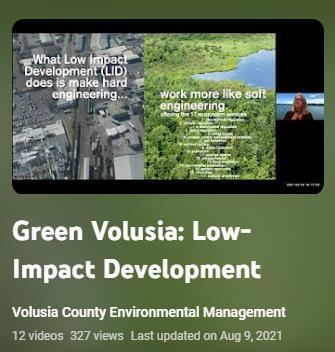
• April – County Council Workshop: Growth and Resource Management and Permitting
• June – County Council Workshop, Creation of Environment and Natural Resources Advisory Committee (ENRAC) -LID is a top priority
• August – County Council accepted DEO Grant and approved Budget Resolution
• October – Grant signed by County Council 2023
• February – Regional Roundtable
Discussion
• April – ENRAC Meeting to discuss DEO
Grant progress on LID Guidebook and Ordinance Recommendations with grant project team.
• April – Green Stormwater
Infrastructure Design Workshop
• April – Green Stormwater
Infrastructure Maintenance Training
• May – ENRAC Meeting to discuss DEO
Grant progress on LID Guidebook and Ordinance Recommendations with grant project team.

Department of Economic Opportunity grant
$75,000 – completion June 2023
Develop ordinance recommendations for LID
◼ Best equitable practices to incorporate LID into land development codes
◼ Ordinance recommendations for County Council to consider to advance resilient nature-based stormwater solutions LID Implementation guidebook
◼ Aid in implementing LID regionally



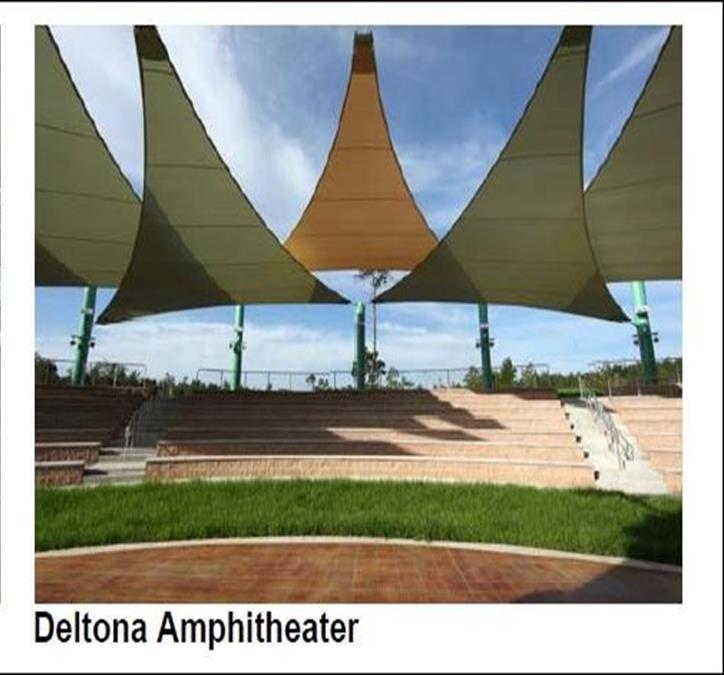

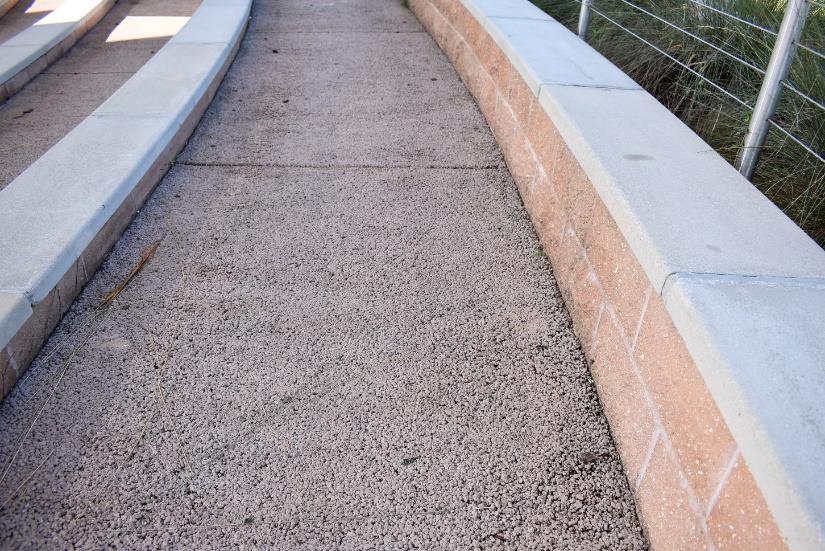
After the grant project . . .
ENRAC Recommendation: “The County Council direct staff to employ the LID+GSI Code Audit Tool to evaluate our Land Development Code (LDC) for existing ordinances that employ LID tools, barriers or conflicts to LID, and opportunities to enhance the use of LID and GSI. This is with the goal of revising the LDC to facilitate a hybrid use of LID and GSI across the county to mitigate flooding and nutrient pollution.“
Using the LID hierarchy of avoid, minimize, mitigate
The more elements you implement, the more incentives you receive

All voluntar y Voluntary with incentives
County Council unanimously directed staff to utilize the LID and GSI Code Audit Tool to evaluate the Land Development Regulations and develop a draft ordinance that encompasses voluntary LID and GSI practices.

• About
• Definitions
• Codes Review Log
• Contact Information
• Scoring Instructions
• Score Summary Local Government Planning and Policy
• Comprehensive Plan
• Zoning Protecting Nature • Natural Resources Protection and Management • Coastal Areas • Trees • Sensitive Groundwater Areas
2
3
4
Practice is clearly described and approved or is allowed with design approval.
Practice is encouraged, but some ambiguity or potential conflict exists.
Practice is mentioned, but without standards or guidance for use.
Where feasible, parking lot islands and perimeter landscaped areas shall be designed and installed to function as stormwater management areas, following design standards for bioretention found in the Stormwater Design Manual. If not feasible, native plants, suitable for the site shall be used.
Parking lot islands and perimeter landscaped areas are encouraged to be designed as part of the site’s stormwater management system, based on bioretention standards in the Stormwater Design Manual. Trees must be planted at a maximum interval of 20 feet.
Landscaped areas in parking lot perimeters and islands may be designed and used as stormwater bioretention areas. 1
Code is silent or significant limits exist, but practice could possibly be used.
Landscaping in parking lot islands and perimeters must achieve a minimum of 75% cover within two years of planting.
Parking lot perimeters shall be graded into a berm with a minimum slope of 2:1, covered with landscaping that will form a dense evergreen screen within tow years of planting. Administrative
and Water Quality • Stormwater Management
• Pollutant Reduction
• Buildings & Landscape
• Permeable
• Construction
• Subdivisions & Greenfield •
Practice is prohibited or very unlikely to be approved.

❑ Hired a student from Stetson University
❑ Assembled core team from Environmental Management (4 staff members)
❑ Identified subject matter experts as the LID Review Team (19 staff members from 7 different county divisions including Planning, Zoning, Building, Land Development, Development Engineering, Traffic, Road and Bridge, Fire Rescue)
❑ Held a kick-off meeting
❑ LID Review Team conducted the audit tool section by section – typical 3-week work period
❑ Core team reviewed each section independently
❑ Compiled all LID Review Team responses
❑ Met with LID Review Team team to review and discuss differences (often 2 meetings)
❑ Compiled all audit results and distribute to LID team for final review

Subject Matter
Experts + EMD LID
Team Member
Review LID Audit Tool Section
EMD LID Team Meeting
Compile all Results
County LID Team LID
Audit Tool Section Review
EMD LID Team cleanup of LID Audit Tool Section
County LID Team Meeting (3 hours)
Tentative Backup County LID Team Meeting (3 hours)






Comprehensive Plan changes to encourage LID practices
Zoning Ordinance and Land Development Code changes to set the standards
Development of a LID Guidance Manual with the details on best management practices (BMPs), incentives, and maintenance requirements
A matrix of the BMP’s and incentives
Adding goals, objectives, and policies to the Future Land Use Element, under our Smart Growth Initiative.
GOAL:
SG 2: To provide alternative development design standards to assist with stormwater management and water quality within Volusia County.
OBJECTIVE:
SG 2.1: To allow implementation of low impact development and green stormwater infrastructure techniques within the development of sites.

SG 2.1.1:Developers are encouraged to use low impact development and green stormwater infrastructure techniques within all land use designations.
SG 2.1.2:Developers utilizing low impact development techniques are encouraged to use innovative land planning and development techniques such as conservation subdivisions, rural clusters, and Waterwise Development.
SG 2.1.3:The land development regulations and any accompanying manual shall set forth a flexible process for authorizing subdivisions and site plans implementing low impact development techniques with innovative designs, incentives, and standards. Incentives may include, but are not limited to, increased density and/or building height, and reduced building setbacks.
SG 2.1.4:Lots shall be arranged in a compact fashion and are authorized and encouraged to be smaller than typically allowed in the zoning classification in urban residential land use classifications.

Section 72-310. – Low Impact Development.
The Low Impact Development Guidance Manual contains incentives including, but not limited to, additional density and height, and reduced setbacks. The identified incentives within the Manual are permitted by right and do not require a public hearing or waiver by the Zoning Enforcement Official to implement. Any deviation of the Zoning Ordinance provisions beyond that expressly permitted by the Manual must be processed as a variance pursuant to division 10 of this article or as a waiver by the Zoning Enforcement Official, as ordinarily required.

Purpose and Applicability.
The purpose of this division is to establish procedures to voluntarily implement low impact development (LID) and green stormwater infrastructure (GSI) practices within any zoning classification in unincorporated Volusia County. Cluster subdivisions and density bonuses shall not occur within rural land use designations. The following regulations set forth a flexible process for authorizing low impact development techniques. Standards.
(a) Notwithstanding any other provisions of this chapter, applications for low impact development subdivisions or final site plans meeting the criteria in this section may be processed as provided in this division. Criteria not specifically addressed within this Division or the Low Impact Development Guidance Manual (Manual), must comply with existing regulations set forth in the Comprehensive Plan, Chapter 50, and Chapter 72 Code of Ordinances. In no instance shall LID best management practices or incentives override the Airport Protection Overlay Zone, Division 7 Flood Hazard Management, or environmental provisions of this Chapter.
a. The Manual shall be the guiding document for best management practices, technical requirements, incentives, and maintenance requirements.

Section 72-1169. - Low Impact Development Site Plan.
(a) Approval required. Granting of a development order is required prior to issuance of a development permit allowing the commencement of site construction of any development.
(b) Procedures. A final site plan application containing LID elements shall be filed and processed pursuant to division 3 of article III, Land Development Regulations.
(c) Required submittals. A final site plan application shall include the items listed within division 3 of article III, Land Development Regulations, and any additional documents listed within the Manual.
a. The Environmental Division is authorized to waive or modify the Environmental Impact Assessment requirements listed within the Manual.



Chapters: 1. Introduction 2. Technical Requirements and Incentives 3. Evaluating Your Site and Planning for LID
Catalog of LID Best Management Practices
Operation and Maintenance of LID Practices
Maintain natural topography
Preserve floodplain
Retain tree canopy and natural vegetation
Retain riparian or vegetated buffers
Cluster and Conservation subdivisions
Common open space
Corridor Protection
Native landscape, fertilizers and irrigation
Habitat restoration or habitat management
Pavement width reduction
Curb elimination and alternative designs

Alternative surface materials
Concentrated parking islands
Minimize building footprint
Minimize total impervious area Minimize directly connected impervious area

Stormwater treatment park
Retention ponds
Detention ponds
Floating wetland mats
Vegetated swale or bioswale
Rain gardens
Underground retention and detention
Infiltration and exfiltration trenches
Biosorption activated media (BAM)
Tree box filters and rainfall interceptor trees
Rainwater harvesting
Vegetated roofs and walls
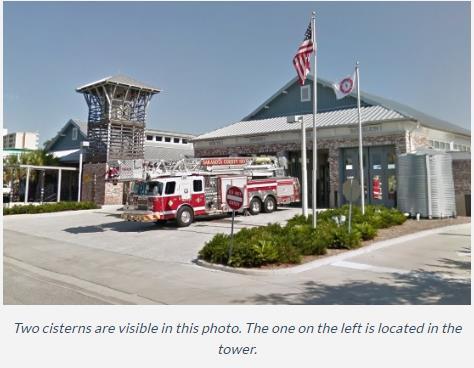
A minimum of 2 are required

Flexible lot sizes
Flexible building setbacks
Additional density or intensity
Increased maximum building height
Increased lot coverage
BMP permitted within landscape buffer and setbacks
BMP permitted within landscape islands and row ends

BMP credited as landscaping
BMP credited as open space
Off-street parking flexibility
Reduction in tree replacement requirements
Reduced building permit, or land development fees
Allow for neighborhood commercial uses






Review by ENRAC Committee September 4
Public comment period Final review and edits Planning and Land Development Review Commission
County Council for adoption


Florida Planning Conference | 6 Sept 2024
M. Jennison Kipp
Sustainable Communities State Specialized Program Agent
UF/IFAS Program for Resource Efficient Communities
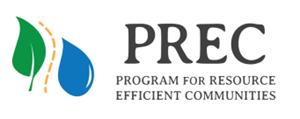
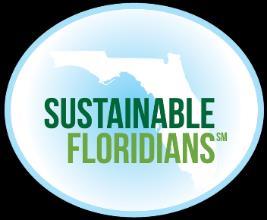


https://1000friendsofflorida.org/florida2070
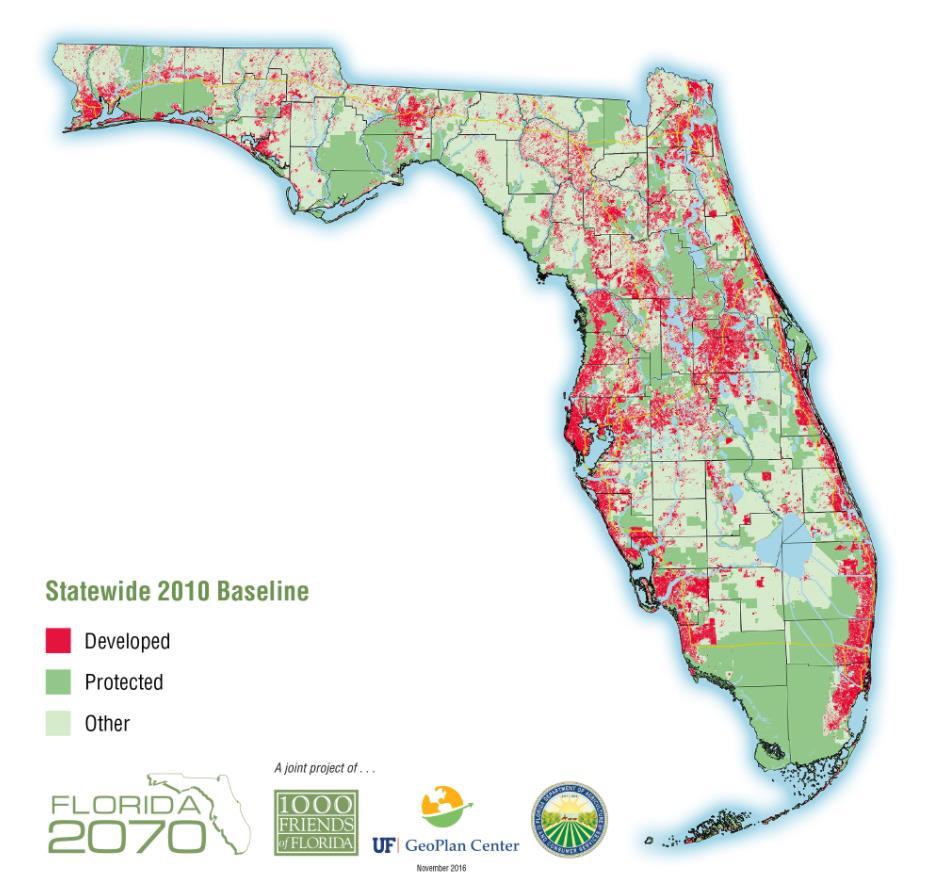

Projected 15 million new residents by 2070


Projected 54% increase in water demand by 2070
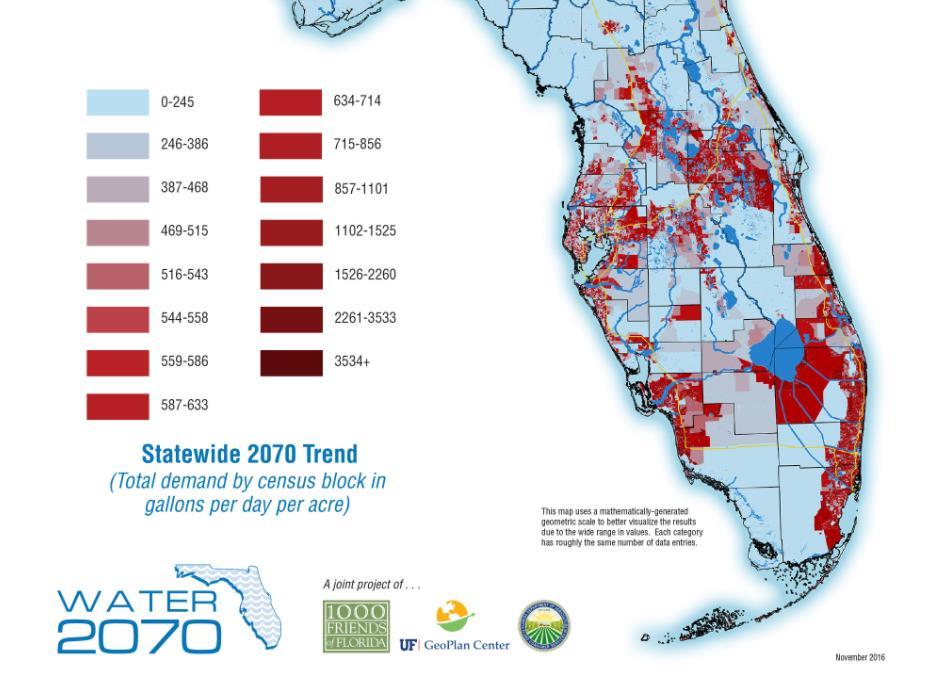
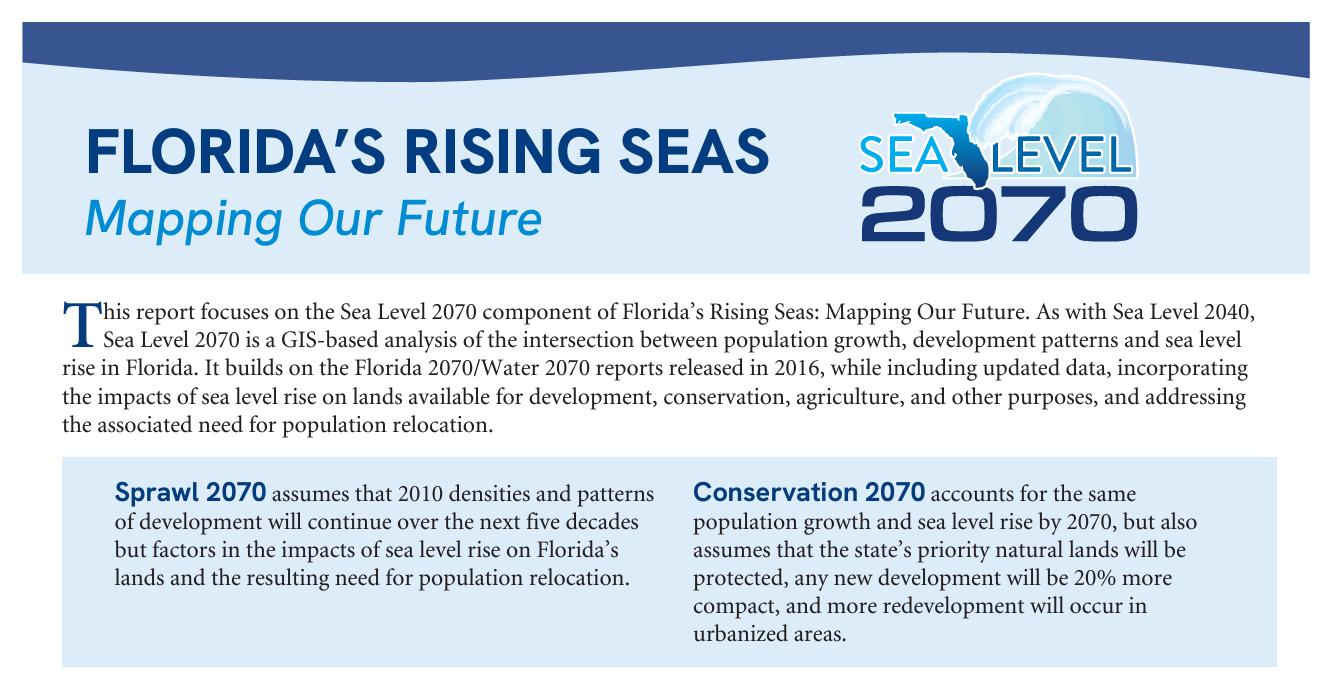


We promote the adoption of best design, construction, and management practices that measurably reduce energy and water consumption and environmental degradation in Florida’s masterplanned residential community developments.



• 2006: Proposed project in Volusia County
• 5,187-acre master plan entitled to have 8,500 dwelling units
• Multi-year permitting process and evolution of project design
• 2009: Restoration was fully entitled based on its re-design to create a mixed-use, transit-oriented community with 3.5 million ft2 of commercial space


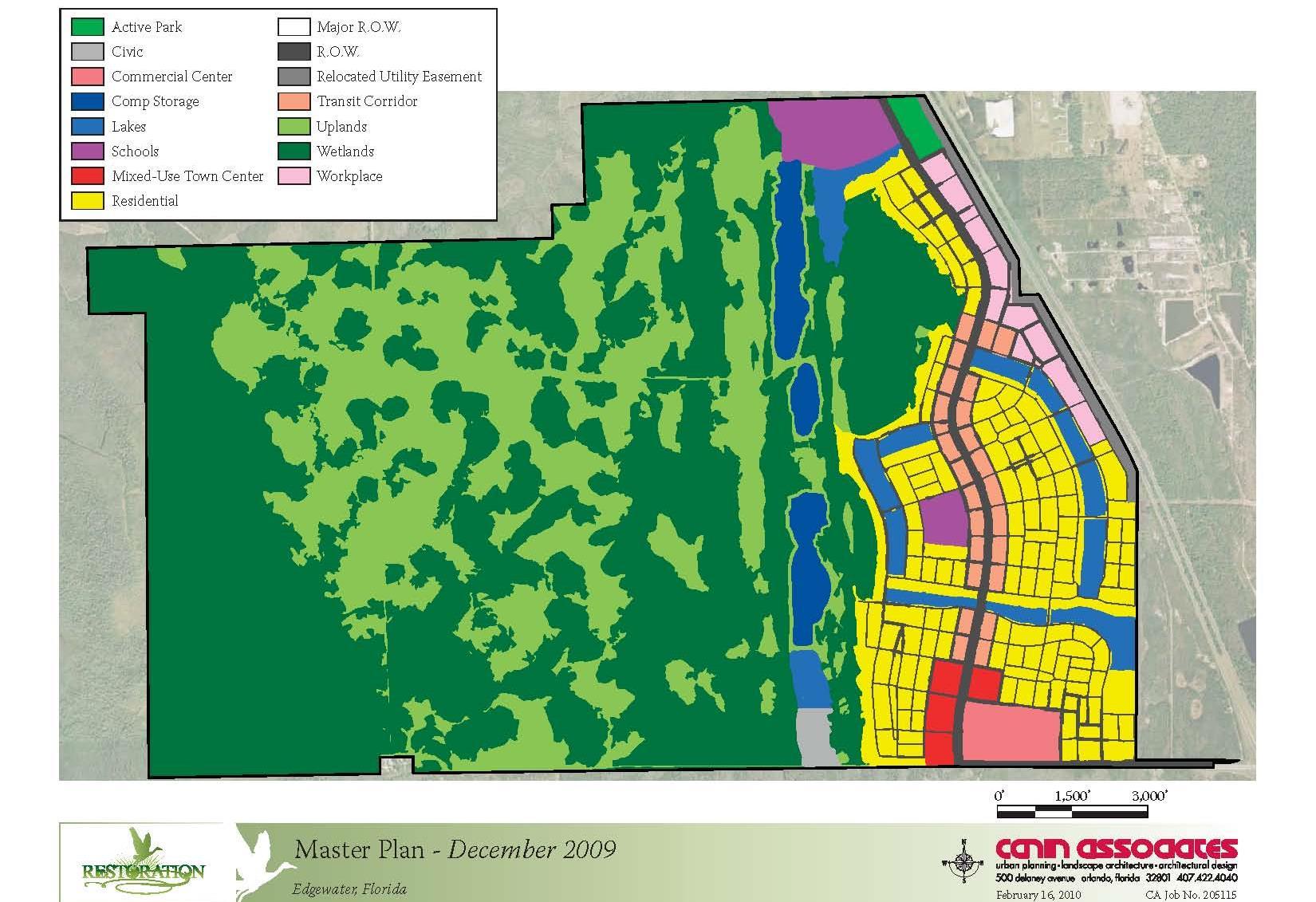
• Road Infrastructure Impacts
• Life-Cycle Analysis (50-years)
• $145 Million Initial Costs Avoided
• 5,855 Metric Tons CO2e/yr Avoided
• Landscaping Impacts
• Annual Inputs & Emissions
• $4 Million/yr in Landscape Inputs & Maintenance Costs Avoided
• 10,887 Metric Tons CO2e/yr Avoided


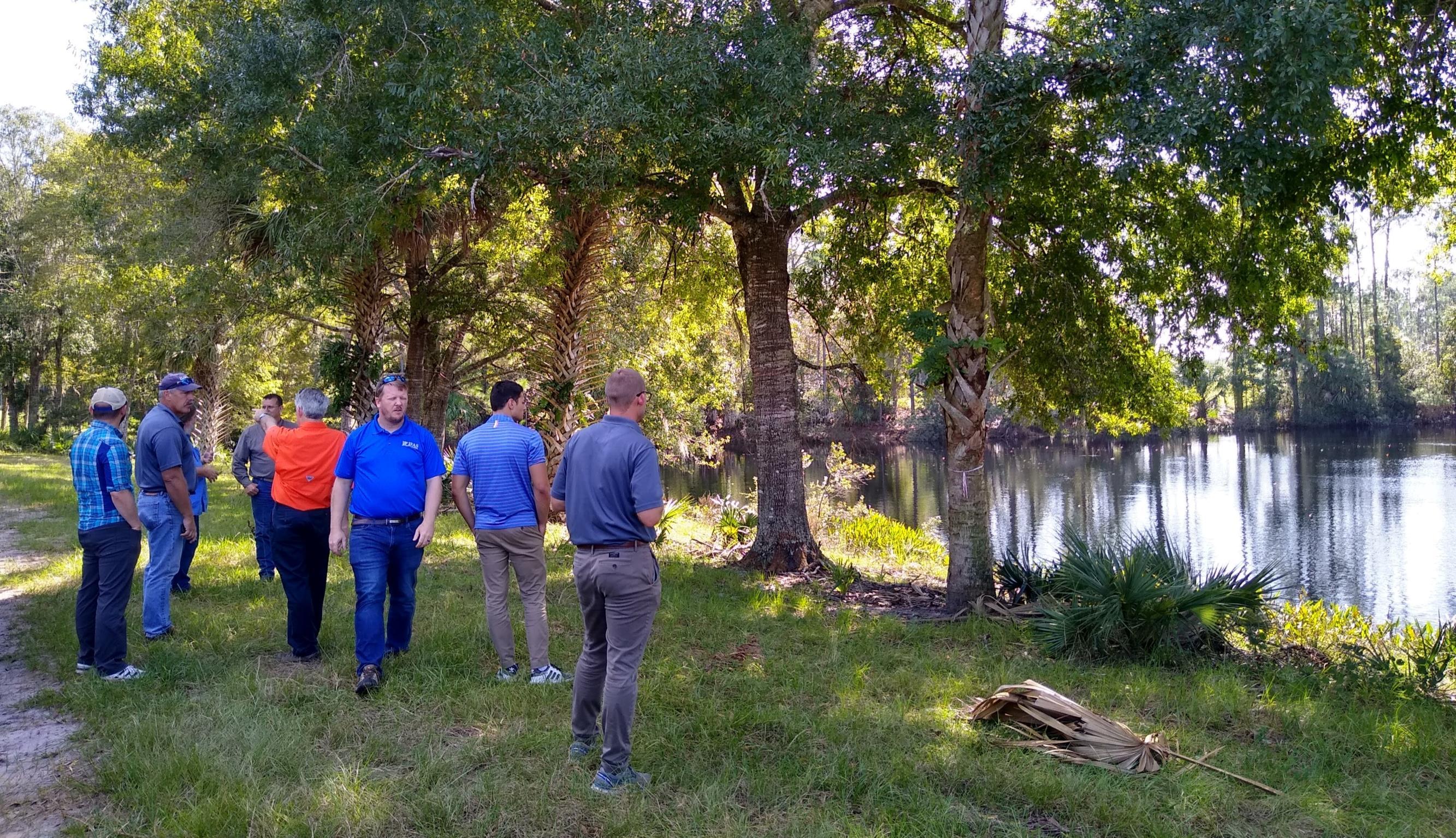
• Volusia & Brevard Counties
• 59,000-acre master-planned development of regional impact
• 23,000 dwelling units and 4.7 million sq. ft. non-residential
• 50-year build out
• Seeds of opportunity planted in 2009 by one planner’s conversation!




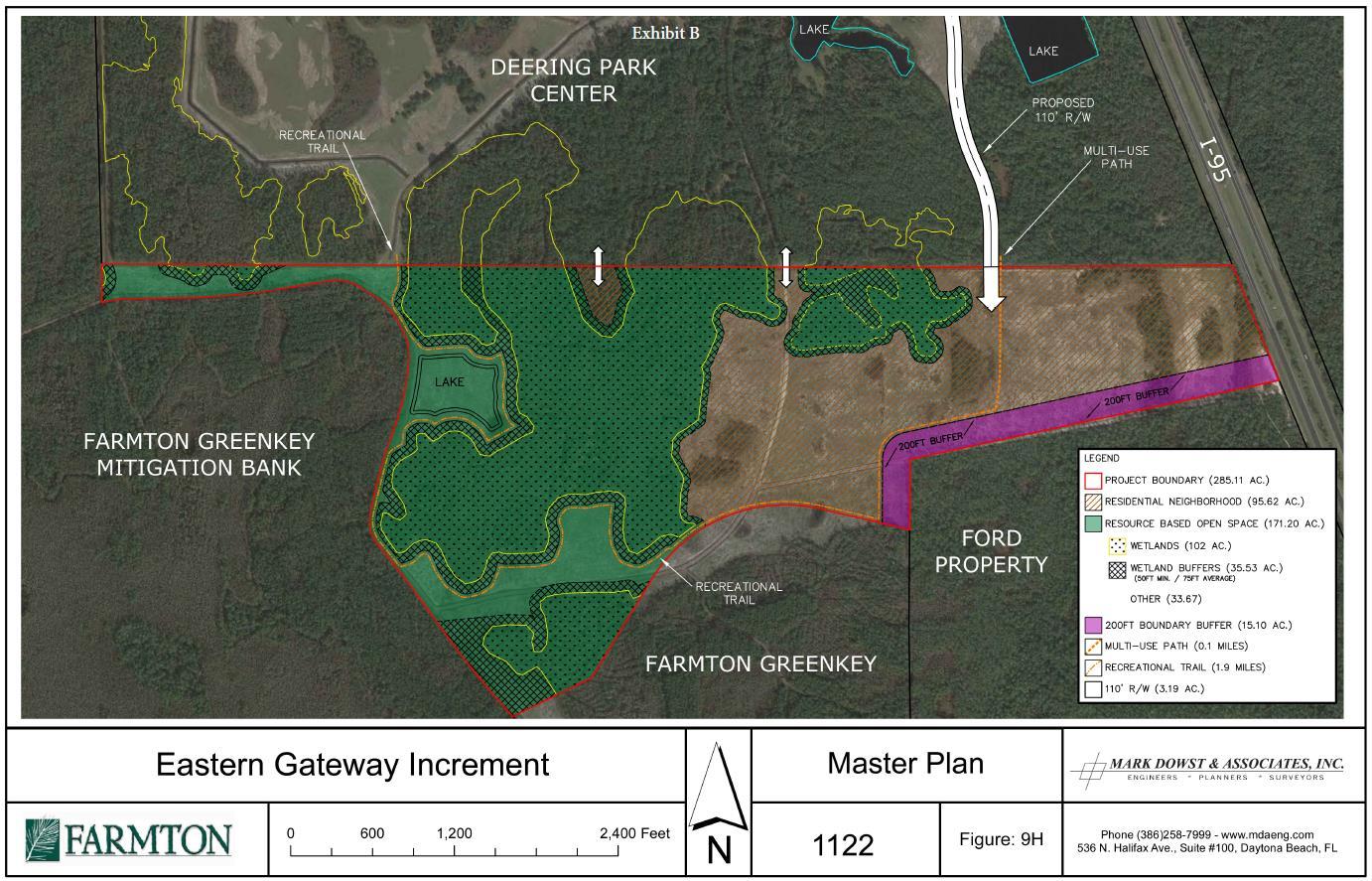
• Energy Conservation
• Water Conservation
• Environmental Preservation
• Mixture of Housing Types & Price Points
• Efficient Infrastructure
• Public Outreach & Educational Opportunities Regarding Sustainability
• Transportation Efficiency
• Water Quality Preservation
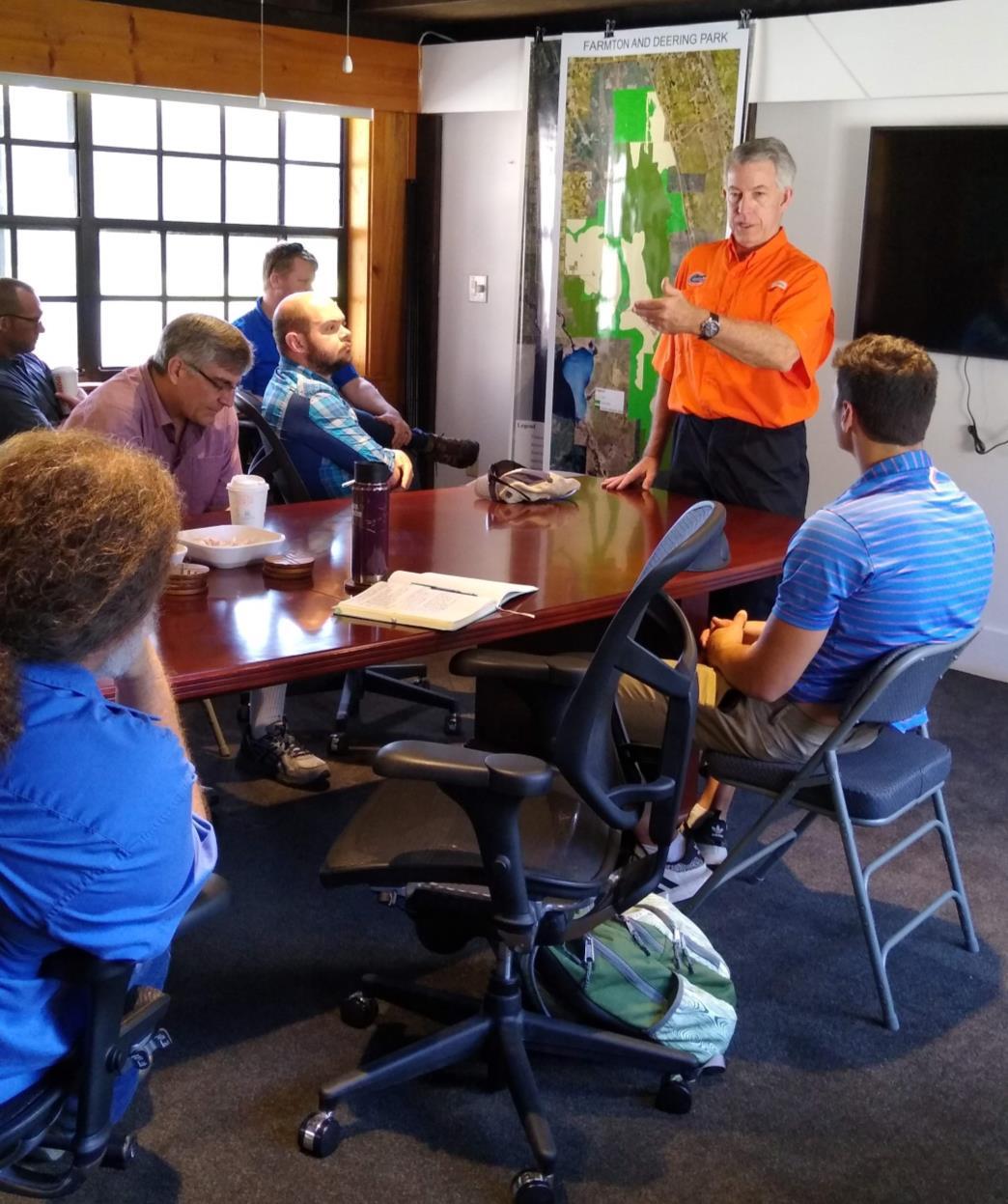
• 3 Big Projects over 50 Years:
• 107,000 Acres of Future Urban Land
• 77,000 New Homes Entitled for Construction
• Sunbridge at scale, potential to save:
• 10.6 MGD of Water (avoided irrigation)
• 1,790 Lbs N per Day (avoided fertilizers)
• $623,000 of Partner & Clientele Investments (since 2018)
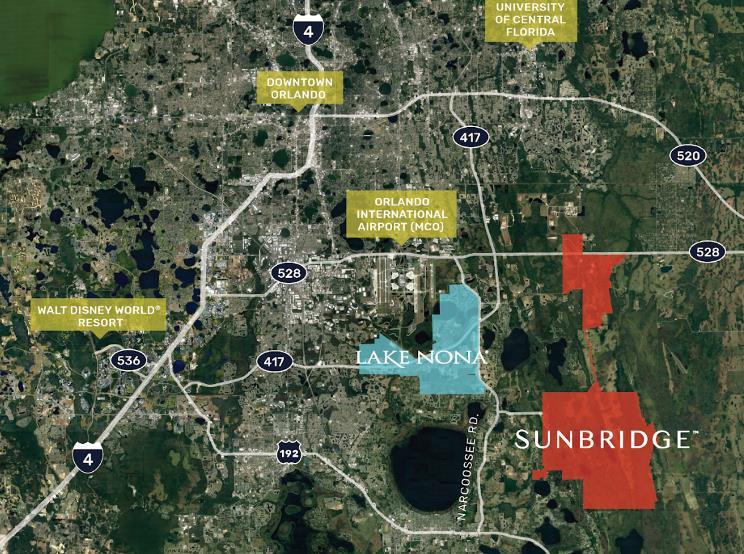
Monitoring Program (SF-BMP)
Goal: To provide a comprehensive, incentive-based, and dynamic sustainability performance framework for new land development projects in Florida




